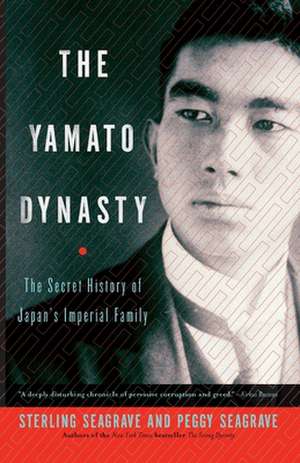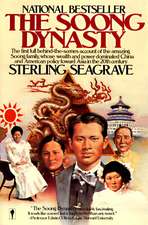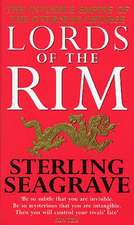The Yamato Dynasty: The Secret History of Japan's Imperial Family
Autor Sterling Seagrave, Peggy Seagraveen Limba Engleză Paperback – 31 iul 2001
Preț: 140.69 lei
Nou
Puncte Express: 211
Preț estimativ în valută:
26.92€ • 29.24$ • 22.62£
26.92€ • 29.24$ • 22.62£
Carte disponibilă
Livrare economică 02-16 aprilie
Preluare comenzi: 021 569.72.76
Specificații
ISBN-13: 9780767904971
ISBN-10: 0767904974
Pagini: 424
Dimensiuni: 139 x 216 x 27 mm
Greutate: 0.54 kg
Editura: BROADWAY BOOKS
ISBN-10: 0767904974
Pagini: 424
Dimensiuni: 139 x 216 x 27 mm
Greutate: 0.54 kg
Editura: BROADWAY BOOKS
Notă biografică
Sterling Seagrave grew up on the China-Burma border. For many years an investigative reporter in Asia, he is the author of Yellow Rain, The Marcos Dynasty, Dragon Lady, The Soong Dynasty, and Lords of the Rim. Peggy Seagrave is Sterling’s wife and longtime collaborator. They live in Europe.
Extras
Chapter 1 Reinventing the Emperor The future Meiji emperor was only eight months old in July 1853 when four large, black-hulled American Navy ships appeared off the entrance to what is now called Tokyo Bay. Two of the heavily gunned warships were steam-powered, spewing smoke and terrifying onlookers. Commanding the squadron was Commodore Matthew Perry, carrying a letter to the Tokugawa shogun from the president of the United States asking Japan to establish commercial and diplomatic relations. For centuries, Japan had been closed to foreigners. Past shoguns had distrusted Western traders and regarded Christian missionaries as subversives who encouraged opposition to the military regime. All Westerners were expelled except a few merchants restricted to a man-made island in the port of Nagasaki. Contact with the outside world became illegal, and Western ships were turned away from Japanese harbors. Commodore Perry refused to be diverted, however, and demanded that the president’s letter be accepted by an official representative of the shogun. After six days of tense confrontation, the Japanese complied and Perry delivered his letter, adding that he expected a positive answer the coming year, when he would return with a larger squadron. To drive his point home he steamed his black ships directly across the bay toward the shogun’s capital. Expecting bombardment, people panicked. Savoring the moment, Perry turned and sailed away.
In his wake he left Japan in crisis, climaxing fifteen years later with the overthrow of the shogun, the restoration of an ancient monarchy after eight centuries in eclipse, and a teenage Meiji emperor on the throne. The Meiji Restoration was followed by other dramatic changes, and in only a few decades Japan was transformed into a world power, today the second biggest economic force on the planet. But in Japan things are rarely what they seem—powerful mythology hides what is really going on. After making a great public display of restoring the emperor to power, the new state obliged the emperor and the imperial family to resume their deep seclusion, hidden by a screen of ritual, protocol and mystification. As one of Meiji’s grandsons exclaimed, they are like “caged birds.” Japan might be liberated from centuries of feudal samurai dictatorship, and be thoroughly modern in most other respects, but the Sons of Heaven, and heaven’s daughters, remain hostages of the past.
Keeping hostages for long periods is a venerable tradition in Asia. What better than to hold the gods themselves captive. This is not just a turn of phrase. For eight centuries Japan’s emperors were kept hostage by military regimes, and defiant emperors were roughly treated. Plots to capture the emperor were central to the overthrow of the shogun in 1868. Once young Meiji was on the throne, he remained in effect a political prisoner to prevent any countercoup by rival forces. And for other important reasons.
On the surface Japan seems to be a passive society devoted to loyalty and consensus. But underneath it is a power country. Treachery, so common throughout its history, made loyalty admired precisely because it is so rare and beautiful. Consensus is idealized, because everyone cheats or colludes behind the scenes. In such a corrupt situation, an icon of divine purity is handy to solve power struggles. As the Son of Heaven, directly descended from mythic gods, and as chief priest and embodiment of all supernatural qualities in the national religion, Shinto, the emperor provides that divine icon. In the past, Japanese strongmen who held the emperor hostage claimed that they derived their office from the throne (meaning from the gods). Anyone who challenged their rule was not only treasonous but blasphemous, deserving terrible punishment. Out of this grew a mythic tradition and a double standard that keep most Japanese submissive and silent even today.
Given the fact that they were gods, it is astonishing how badly the Yamato emperors have been treated over the centuries. While some lived in perfumed silks, others were betrayed, poisoned, dethroned, exiled or driven to suicide. Those who cooperated were surrounded by chamberlains and court ladies who often were snoops and spies for the real strongmen. Under those conditions, being a god was far more dangerous than being ordinary. As gods, emperors were magical, but in reality they were powerless because all real power was held by regents or shoguns. Nothing has changed today.
As a child, Meiji’s future was highly uncertain. He was not the son of an empress, but of Emperor Komei’s favorite concubine, Nakayama Yoshiko, daughter of a court noble. He was born on November 3, 1852, at his mother’s childhood home, one of many noble mansions built around the edge of the imperial palace grounds in Kyoto. As a precaution, the baby was given his first bath in the Well of Divine Help. They called him Sachi no Miya—Miya being one of three words for prince. In 1860, when he was eight years old, he was adopted by the empress as the formal heir, and given the name Mutsuhito Shinno (Prince Mutsuhito). Meiji was a formal reign title chosen later when he became emperor. (Because it is confusing to call one emperor by his reign title [Meiji] and another by his given name [Hirohito], we will use given names for our main characters where possible, reserving reign titles for certain purposes.)
Of Emperor Komei’s six children—two boys and four girls—Mutsuhito was the only one to survive beyond the age of four. Infant mortality ran high in the nobility after centuries of inbreeding for strategic marriages and political liaisons. Because the aristocracy isolated itself from ordinary people, it developed little natural resistance to infections or endemic diseases like meningitis. Komei himself was one of fifteen children, but only three reached maturity.
In a highly competitive court, infanticide was also a danger, so during his first five years Prince Mutsuhito was separated from his parents and sheltered from intrigue at the home of his mater- nal grandfather, Lord Nakayama. Two wet nurses were with him around the clock as imperial infants were fed every two hours day and night. In 1854, when Mutsuhito was two years old, the Kyoto imperial palace burned down, so the emperor came to live for a while at the Nakayama mansion and grew fond of his son.
Physically delicate and rather effeminate, like a tender asparagus shoot, Mutsuhito was a headstrong child who would fly into tantrums, break his toys and hit his noble playmates, who were forbidden to retaliate. Little Japanese boys are rarely disciplined. Mutsuhito’s tantrums continued even as a grown man. To strengthen the toddler, Lord Nakayama gave him a wooden horse and a bamboo sword, and encouraged him to play samurai. From this the boy developed a love of horses and swords, not as weapons but as playthings and treasures. Strenuous exercise gave him a hearty appetite and a robust appearance, although he was never really robust. From Lord Nakayama’s diary we know he hovered over his grandson, worrying about every bruise. At age five the crown prince was taken back to the rebuilt palace, to live in a new pavilion with white walls and a black tile roof overlooking a pond full of carp and gardens of evergreens, weeping plum and black-stemmed bamboo. There his father gave him lessons in poetry while scholars tutored him in a range of subjects. History and geography were his favorites. Many of his questions concerned the foreigners who were appearing in Japan in increasing numbers since the arrival of Perry’s black ships. He saw them in the streets of Kyoto on those rare occasions when he was allowed out of the palace to see the changing autumn leaves or the spring clouds of cherry blossoms. These excursions were made in a black lacquered cart, a black box on wheels drawn by two carefully washed white bullocks. In the wagon, the crown prince was shielded from view by roll-down bamboo shades, through which he peered with great excitement.
In the palace, Mutsuhito was surrounded by nearly three hundred women. They controlled who saw him, what he could do and not do, what he wore, what he ate and when he went to bed. These ladies-in-waiting were chosen from families of nobles when they were young girls, and most spent their entire lives in the palace. Parents were eager to volunteer their daughters because having a family member in the emperor’s inner apartments gave them influence at court. All spoke an archaic form of Japanese called gosho kotoba or palace language, incomprehensible to most Japanese. A rigid pecking order gave great power to court ladies of higher rank. They could keep an emperor isolated, to the fury of his ministers. Among them over the centuries were individuals of extraordinary intellect and talent, such as Lady Murasaki in the eleventh century, who wrote a masterpiece, The Tale of Genji. But there were also many who were ignorant, or conspiratorial. It was their responsibility to serve or amuse the emperor and make certain he had plenty of heirs, if the empress failed to oblige. Mutsuhito’s mother was a court lady fortunate enough to become an imperial concubine. These women had their own intelligence network reaching all corners of Japan, so it was often from them that the emperor had his first news of events outside Kyoto, or heard of conspiracies.
Meals were served by court ladies wearing cotton masks over their mouths for hygiene. When they knelt to perform obeisance, only the backs of their hands touched the mats, to avoid contamination. They could not put on their own socks, and when they sewed garments for the imperial family they could not moisten the thread with their own saliva. The crown prince ate with chopsticks, but his were one inch longer than those of anyone else except the emperor, who had nine-inch chopsticks. In Japan, the presentation of food was all important, so the eyes were better fed than the stomach. Sometimes Mutsuhito tried Western foods, but he rarely ate meat other than chicken.
Emperor Komei did not share his son’s interest in foreign things. He made no secret of his intense dislike of all foreigners. One of his poems goes, “Perish my body neath the cold clear wave of some dark well, but let no foreign foot pollute the water with its presence here.” Still in his early twenties when Perry arrived, the emperor bitterly criticized the shogunate for not standing up to the West. This was not entirely true. For many years, probes by European trading nations had been blocked, some fired upon. Russian vessels were turned back, their crews imprisoned. In 1846, when two American sailing ships arrived under the command of Commodore James Biddle, they were intercepted and towed back to sea. Generally, however, foreign skippers were treated with courtesy, supplied with food and water, and only then urged to leave because of the exclusion law. When sail gave way to steam, Japan became important as a coaling station, as a bad-weather refuge for whalers and as a big potential market for products of the industrial revolution. America increasingly saw itself as a Pacific player, so Commodore Perry was ordered to open up Japan, by force if necessary.
Many Japanese were in favor of foreign trade, foreign ideas and foreign technology. With Japan closed, food was not imported even during famines. Opening Japan to the world, they argued, meant opening the world to Japan, with all that could mean in manufacturing technology, education, science and medicine, and the exploitation of natural resources elsewhere that the islands lacked. Others disagreed violently. Japan had multiple personalities: friendly, hostile, humane, brutal, enlightened, barbaric. Contrary moods swept over the islands like pods of rain squalls. For all those eager to open up, there were fanatics ready to behead them.
The shogun’s samurai armies were not up to any serious contest. China’s quick defeat by Britain in the First Opium War in 1842 made it obvious that losing would bring humiliation, which Japan could not face with the same resignation as China. The best strategy was to avoid war by making a bargain. So on his return a few months later, Commodore Perry was given a favorable reply. Without asking for the consent of Emperor Komei (a good measure of his insignificance), the shogunate signed a treaty with America, followed later by similar treaties with Great Britain, Russia, Germany, Holland and France. The treaty-holders were exempted from Japanese law, and were allowed to export goods to Japan at favorable prices. After centuries of seclusion, the intrusion of foreigners was traumatic to many Japanese. The garish dress and behavior of Westerners was offensive. One official mourned, “For more than ten years our country was in a state of indescribable confusion.”
The weakness of the shogun’s government had been apparent to some for a long time, but was made obvious to everyone by these lopsided new treaties. Once a powerful military dictatorship, the shogunate had been set up to benefit Japan’s feudal military class, the samurai. Tyrannical shoguns became decadent in their private behavior. In the first half of the nineteenth century, Japan suffered under the most degenerate shogun in history, Ienari, an “exhausted voluptuary” who kept a harem of nine hundred women and fathered at least fifty-five children. His ministers were famously corrupt, procuring girls and boys for their master, arranging bribes and swindles through court ladies in the shogun’s bedchambers. Corruption was becoming contagious in Japan. The reckless printing of unsupported paper money fed a craze of pleasure-seeking in the cities, and brothels boomed.
The issue facing most Japanese in the middle of the nineteenth century was economic survival. Most of the shogun’s samurai supporters had mismanaged their feudal estates. Some squandered assets on sumptuous living, or wasted their lives on conspiracy. Only the hardest-working remained strong, on great estates far from the capital, relatively independent of the central government. Even so, lords of the greatest domains were obliged by the shogun to maintain lavish households in the capital, which was ruinously expensive. Smaller fiefdoms also were deeply in debt. The growth of a money economy encouraged people to borrow ruinously, and wealth shifted from old gentry to money-lending upstarts. Merchants and bankers grew rich but lived in constant danger of being vic- timized by the predatory regime. Many were the horror stories, like the rich merchant who died in prison while his sons and business manager were crucified, and all their wealth confiscated.
In his wake he left Japan in crisis, climaxing fifteen years later with the overthrow of the shogun, the restoration of an ancient monarchy after eight centuries in eclipse, and a teenage Meiji emperor on the throne. The Meiji Restoration was followed by other dramatic changes, and in only a few decades Japan was transformed into a world power, today the second biggest economic force on the planet. But in Japan things are rarely what they seem—powerful mythology hides what is really going on. After making a great public display of restoring the emperor to power, the new state obliged the emperor and the imperial family to resume their deep seclusion, hidden by a screen of ritual, protocol and mystification. As one of Meiji’s grandsons exclaimed, they are like “caged birds.” Japan might be liberated from centuries of feudal samurai dictatorship, and be thoroughly modern in most other respects, but the Sons of Heaven, and heaven’s daughters, remain hostages of the past.
Keeping hostages for long periods is a venerable tradition in Asia. What better than to hold the gods themselves captive. This is not just a turn of phrase. For eight centuries Japan’s emperors were kept hostage by military regimes, and defiant emperors were roughly treated. Plots to capture the emperor were central to the overthrow of the shogun in 1868. Once young Meiji was on the throne, he remained in effect a political prisoner to prevent any countercoup by rival forces. And for other important reasons.
On the surface Japan seems to be a passive society devoted to loyalty and consensus. But underneath it is a power country. Treachery, so common throughout its history, made loyalty admired precisely because it is so rare and beautiful. Consensus is idealized, because everyone cheats or colludes behind the scenes. In such a corrupt situation, an icon of divine purity is handy to solve power struggles. As the Son of Heaven, directly descended from mythic gods, and as chief priest and embodiment of all supernatural qualities in the national religion, Shinto, the emperor provides that divine icon. In the past, Japanese strongmen who held the emperor hostage claimed that they derived their office from the throne (meaning from the gods). Anyone who challenged their rule was not only treasonous but blasphemous, deserving terrible punishment. Out of this grew a mythic tradition and a double standard that keep most Japanese submissive and silent even today.
Given the fact that they were gods, it is astonishing how badly the Yamato emperors have been treated over the centuries. While some lived in perfumed silks, others were betrayed, poisoned, dethroned, exiled or driven to suicide. Those who cooperated were surrounded by chamberlains and court ladies who often were snoops and spies for the real strongmen. Under those conditions, being a god was far more dangerous than being ordinary. As gods, emperors were magical, but in reality they were powerless because all real power was held by regents or shoguns. Nothing has changed today.
As a child, Meiji’s future was highly uncertain. He was not the son of an empress, but of Emperor Komei’s favorite concubine, Nakayama Yoshiko, daughter of a court noble. He was born on November 3, 1852, at his mother’s childhood home, one of many noble mansions built around the edge of the imperial palace grounds in Kyoto. As a precaution, the baby was given his first bath in the Well of Divine Help. They called him Sachi no Miya—Miya being one of three words for prince. In 1860, when he was eight years old, he was adopted by the empress as the formal heir, and given the name Mutsuhito Shinno (Prince Mutsuhito). Meiji was a formal reign title chosen later when he became emperor. (Because it is confusing to call one emperor by his reign title [Meiji] and another by his given name [Hirohito], we will use given names for our main characters where possible, reserving reign titles for certain purposes.)
Of Emperor Komei’s six children—two boys and four girls—Mutsuhito was the only one to survive beyond the age of four. Infant mortality ran high in the nobility after centuries of inbreeding for strategic marriages and political liaisons. Because the aristocracy isolated itself from ordinary people, it developed little natural resistance to infections or endemic diseases like meningitis. Komei himself was one of fifteen children, but only three reached maturity.
In a highly competitive court, infanticide was also a danger, so during his first five years Prince Mutsuhito was separated from his parents and sheltered from intrigue at the home of his mater- nal grandfather, Lord Nakayama. Two wet nurses were with him around the clock as imperial infants were fed every two hours day and night. In 1854, when Mutsuhito was two years old, the Kyoto imperial palace burned down, so the emperor came to live for a while at the Nakayama mansion and grew fond of his son.
Physically delicate and rather effeminate, like a tender asparagus shoot, Mutsuhito was a headstrong child who would fly into tantrums, break his toys and hit his noble playmates, who were forbidden to retaliate. Little Japanese boys are rarely disciplined. Mutsuhito’s tantrums continued even as a grown man. To strengthen the toddler, Lord Nakayama gave him a wooden horse and a bamboo sword, and encouraged him to play samurai. From this the boy developed a love of horses and swords, not as weapons but as playthings and treasures. Strenuous exercise gave him a hearty appetite and a robust appearance, although he was never really robust. From Lord Nakayama’s diary we know he hovered over his grandson, worrying about every bruise. At age five the crown prince was taken back to the rebuilt palace, to live in a new pavilion with white walls and a black tile roof overlooking a pond full of carp and gardens of evergreens, weeping plum and black-stemmed bamboo. There his father gave him lessons in poetry while scholars tutored him in a range of subjects. History and geography were his favorites. Many of his questions concerned the foreigners who were appearing in Japan in increasing numbers since the arrival of Perry’s black ships. He saw them in the streets of Kyoto on those rare occasions when he was allowed out of the palace to see the changing autumn leaves or the spring clouds of cherry blossoms. These excursions were made in a black lacquered cart, a black box on wheels drawn by two carefully washed white bullocks. In the wagon, the crown prince was shielded from view by roll-down bamboo shades, through which he peered with great excitement.
In the palace, Mutsuhito was surrounded by nearly three hundred women. They controlled who saw him, what he could do and not do, what he wore, what he ate and when he went to bed. These ladies-in-waiting were chosen from families of nobles when they were young girls, and most spent their entire lives in the palace. Parents were eager to volunteer their daughters because having a family member in the emperor’s inner apartments gave them influence at court. All spoke an archaic form of Japanese called gosho kotoba or palace language, incomprehensible to most Japanese. A rigid pecking order gave great power to court ladies of higher rank. They could keep an emperor isolated, to the fury of his ministers. Among them over the centuries were individuals of extraordinary intellect and talent, such as Lady Murasaki in the eleventh century, who wrote a masterpiece, The Tale of Genji. But there were also many who were ignorant, or conspiratorial. It was their responsibility to serve or amuse the emperor and make certain he had plenty of heirs, if the empress failed to oblige. Mutsuhito’s mother was a court lady fortunate enough to become an imperial concubine. These women had their own intelligence network reaching all corners of Japan, so it was often from them that the emperor had his first news of events outside Kyoto, or heard of conspiracies.
Meals were served by court ladies wearing cotton masks over their mouths for hygiene. When they knelt to perform obeisance, only the backs of their hands touched the mats, to avoid contamination. They could not put on their own socks, and when they sewed garments for the imperial family they could not moisten the thread with their own saliva. The crown prince ate with chopsticks, but his were one inch longer than those of anyone else except the emperor, who had nine-inch chopsticks. In Japan, the presentation of food was all important, so the eyes were better fed than the stomach. Sometimes Mutsuhito tried Western foods, but he rarely ate meat other than chicken.
Emperor Komei did not share his son’s interest in foreign things. He made no secret of his intense dislike of all foreigners. One of his poems goes, “Perish my body neath the cold clear wave of some dark well, but let no foreign foot pollute the water with its presence here.” Still in his early twenties when Perry arrived, the emperor bitterly criticized the shogunate for not standing up to the West. This was not entirely true. For many years, probes by European trading nations had been blocked, some fired upon. Russian vessels were turned back, their crews imprisoned. In 1846, when two American sailing ships arrived under the command of Commodore James Biddle, they were intercepted and towed back to sea. Generally, however, foreign skippers were treated with courtesy, supplied with food and water, and only then urged to leave because of the exclusion law. When sail gave way to steam, Japan became important as a coaling station, as a bad-weather refuge for whalers and as a big potential market for products of the industrial revolution. America increasingly saw itself as a Pacific player, so Commodore Perry was ordered to open up Japan, by force if necessary.
Many Japanese were in favor of foreign trade, foreign ideas and foreign technology. With Japan closed, food was not imported even during famines. Opening Japan to the world, they argued, meant opening the world to Japan, with all that could mean in manufacturing technology, education, science and medicine, and the exploitation of natural resources elsewhere that the islands lacked. Others disagreed violently. Japan had multiple personalities: friendly, hostile, humane, brutal, enlightened, barbaric. Contrary moods swept over the islands like pods of rain squalls. For all those eager to open up, there were fanatics ready to behead them.
The shogun’s samurai armies were not up to any serious contest. China’s quick defeat by Britain in the First Opium War in 1842 made it obvious that losing would bring humiliation, which Japan could not face with the same resignation as China. The best strategy was to avoid war by making a bargain. So on his return a few months later, Commodore Perry was given a favorable reply. Without asking for the consent of Emperor Komei (a good measure of his insignificance), the shogunate signed a treaty with America, followed later by similar treaties with Great Britain, Russia, Germany, Holland and France. The treaty-holders were exempted from Japanese law, and were allowed to export goods to Japan at favorable prices. After centuries of seclusion, the intrusion of foreigners was traumatic to many Japanese. The garish dress and behavior of Westerners was offensive. One official mourned, “For more than ten years our country was in a state of indescribable confusion.”
The weakness of the shogun’s government had been apparent to some for a long time, but was made obvious to everyone by these lopsided new treaties. Once a powerful military dictatorship, the shogunate had been set up to benefit Japan’s feudal military class, the samurai. Tyrannical shoguns became decadent in their private behavior. In the first half of the nineteenth century, Japan suffered under the most degenerate shogun in history, Ienari, an “exhausted voluptuary” who kept a harem of nine hundred women and fathered at least fifty-five children. His ministers were famously corrupt, procuring girls and boys for their master, arranging bribes and swindles through court ladies in the shogun’s bedchambers. Corruption was becoming contagious in Japan. The reckless printing of unsupported paper money fed a craze of pleasure-seeking in the cities, and brothels boomed.
The issue facing most Japanese in the middle of the nineteenth century was economic survival. Most of the shogun’s samurai supporters had mismanaged their feudal estates. Some squandered assets on sumptuous living, or wasted their lives on conspiracy. Only the hardest-working remained strong, on great estates far from the capital, relatively independent of the central government. Even so, lords of the greatest domains were obliged by the shogun to maintain lavish households in the capital, which was ruinously expensive. Smaller fiefdoms also were deeply in debt. The growth of a money economy encouraged people to borrow ruinously, and wealth shifted from old gentry to money-lending upstarts. Merchants and bankers grew rich but lived in constant danger of being vic- timized by the predatory regime. Many were the horror stories, like the rich merchant who died in prison while his sons and business manager were crucified, and all their wealth confiscated.
Recenzii
"The Seagraves have uncovered one of the biggest secrets of the twentieth century"
--Iris Chang, author of The Rape of Nanking
"[The Yamato Dynasty] dramatically brings the imperial family–and those behind it–to life, offering readers an intriguing glimpse behind the long-maintained veil of secrecy."
--Publishers Weekly (starred review)
--Iris Chang, author of The Rape of Nanking
"[The Yamato Dynasty] dramatically brings the imperial family–and those behind it–to life, offering readers an intriguing glimpse behind the long-maintained veil of secrecy."
--Publishers Weekly (starred review)
Descriere
Unearthing page-turning revelations, the Seagraves have written the first complete account of the Yamato imperial family dynasty, from Emperor Meiji in 1852 to the present day.


















